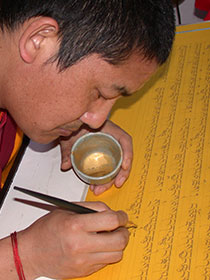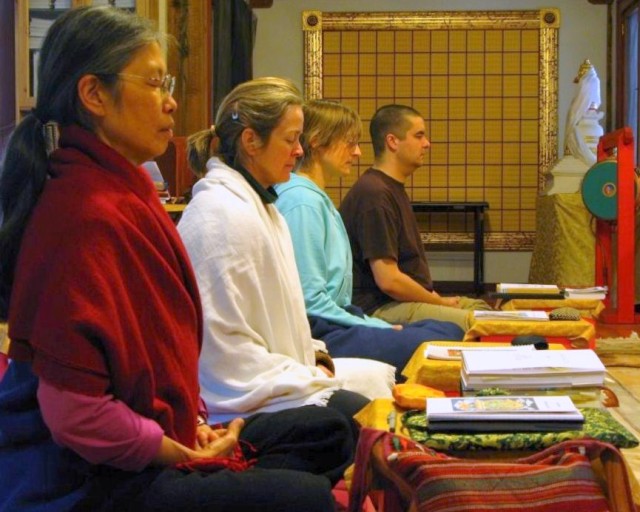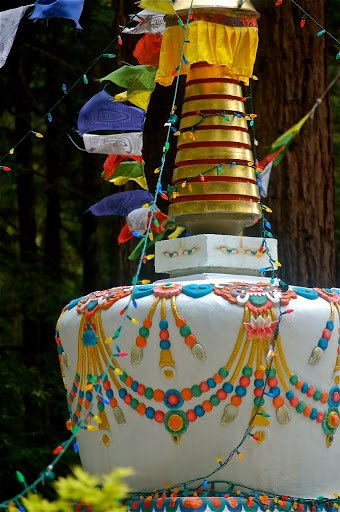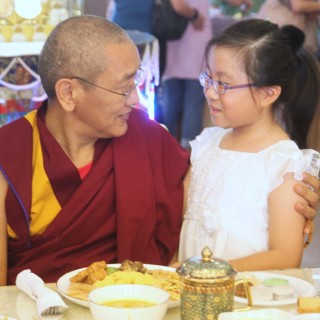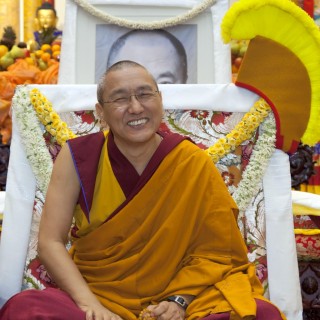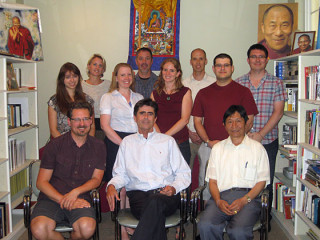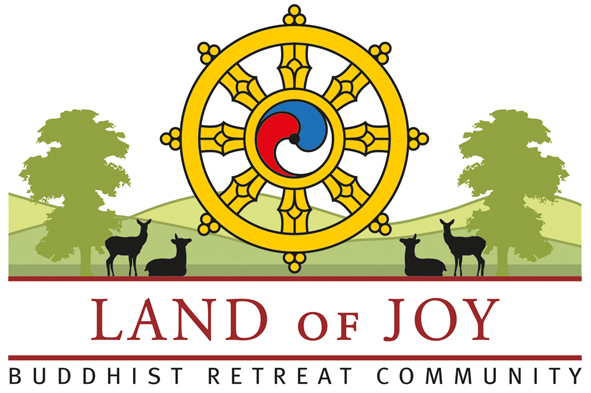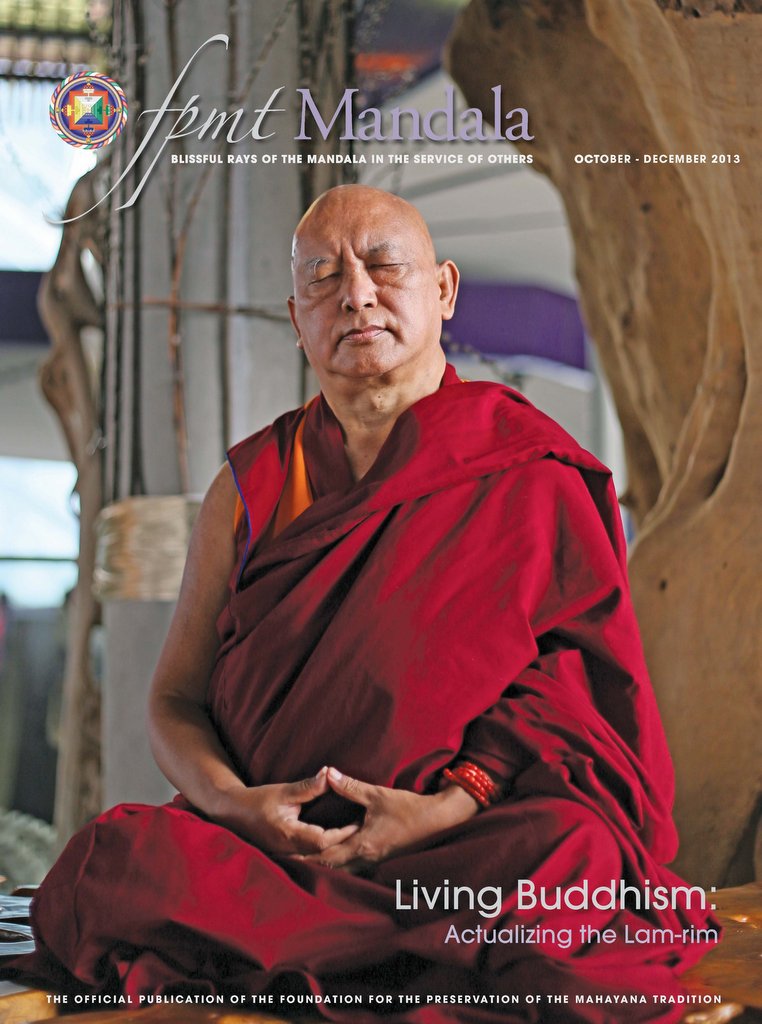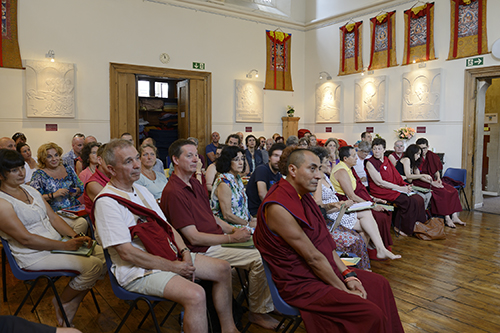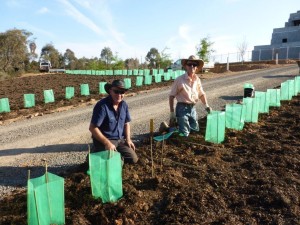- Home
- FPMT Homepage
Foundation for the Preservation of the Mahayana Tradition
The FPMT is an organization devoted to preserving and spreading Mahayana Buddhism worldwide by creating opportunities to listen, reflect, meditate, practice and actualize the unmistaken teachings of the Buddha and based on that experience spreading the Dharma to sentient beings. We provide integrated education through which people’s minds and hearts can be transformed into their highest potential for the benefit of others, inspired by an attitude of universal responsibility and service. We are committed to creating harmonious environments and helping all beings develop their full potential of infinite wisdom and compassion. Our organization is based on the Buddhist tradition of Lama Tsongkhapa of Tibet as taught to us by our founders Lama Thubten Yeshe and Lama Thubten Zopa Rinpoche.
- Willkommen
Die Stiftung zur Erhaltung der Mahayana Tradition (FPMT) ist eine Organisation, die sich weltweit für die Erhaltung und Verbreitung des Mahayana-Buddhismus einsetzt, indem sie Möglichkeiten schafft, den makellosen Lehren des Buddha zuzuhören, über sie zur reflektieren und zu meditieren und auf der Grundlage dieser Erfahrung das Dharma unter den Lebewesen zu verbreiten.
Wir bieten integrierte Schulungswege an, durch denen der Geist und das Herz der Menschen in ihr höchstes Potential verwandelt werden zum Wohl der anderen – inspiriert durch eine Haltung der universellen Verantwortung und dem Wunsch zu dienen. Wir haben uns verpflichtet, harmonische Umgebungen zu schaffen und allen Wesen zu helfen, ihr volles Potenzial unendlicher Weisheit und grenzenlosen Mitgefühls zu verwirklichen.
Unsere Organisation basiert auf der buddhistischen Tradition von Lama Tsongkhapa von Tibet, so wie sie uns von unseren Gründern Lama Thubten Yeshe und Lama Thubten Zopa Rinpoche gelehrt wird.
- Bienvenidos
La Fundación para la preservación de la tradición Mahayana (FPMT) es una organización que se dedica a preservar y difundir el budismo Mahayana en todo el mundo, creando oportunidades para escuchar, reflexionar, meditar, practicar y actualizar las enseñanzas inconfundibles de Buda y en base a esa experiencia difundir el Dharma a los seres.
Proporcionamos una educación integrada a través de la cual las mentes y los corazones de las personas se pueden transformar en su mayor potencial para el beneficio de los demás, inspirados por una actitud de responsabilidad y servicio universales. Estamos comprometidos a crear ambientes armoniosos y ayudar a todos los seres a desarrollar todo su potencial de infinita sabiduría y compasión.
Nuestra organización se basa en la tradición budista de Lama Tsongkhapa del Tíbet como nos lo enseñaron nuestros fundadores Lama Thubten Yeshe y Lama Zopa Rinpoche.
A continuación puede ver una lista de los centros y sus páginas web en su lengua preferida.
- Bienvenue
L’organisation de la FPMT a pour vocation la préservation et la diffusion du bouddhisme du mahayana dans le monde entier. Elle offre l’opportunité d’écouter, de réfléchir, de méditer, de pratiquer et de réaliser les enseignements excellents du Bouddha, pour ensuite transmettre le Dharma à tous les êtres. Nous proposons une formation intégrée grâce à laquelle le cœur et l’esprit de chacun peuvent accomplir leur potentiel le plus élevé pour le bien d’autrui, inspirés par le sens du service et une responsabilité universelle. Nous nous engageons à créer un environnement harmonieux et à aider tous les êtres à épanouir leur potentiel illimité de compassion et de sagesse. Notre organisation s’appuie sur la tradition guéloukpa de Lama Tsongkhapa du Tibet, telle qu’elle a été enseignée par nos fondateurs Lama Thoubtèn Yéshé et Lama Zopa Rinpoché.
Visitez le site de notre Editions Mahayana pour les traductions, conseils et nouvelles du Bureau international en français.
Voici une liste de centres et de leurs sites dans votre langue préférée
- Benvenuto
L’FPMT è un organizzazione il cui scopo è preservare e diffondere il Buddhismo Mahayana nel mondo, creando occasioni di ascolto, riflessione, meditazione e pratica dei perfetti insegnamenti del Buddha, al fine di attualizzare e diffondere il Dharma fra tutti gli esseri senzienti.
Offriamo un’educazione integrata, che può trasformare la mente e i cuori delle persone nel loro massimo potenziale, per il beneficio di tutti gli esseri, ispirati da un’attitudine di responsabilità universale e di servizio.
Il nostro obiettivo è quello di creare contesti armoniosi e aiutare tutti gli esseri a sviluppare in modo completo le proprie potenzialità di infinita saggezza e compassione.
La nostra organizzazione si basa sulla tradizione buddhista di Lama Tsongkhapa del Tibet, così come ci è stata insegnata dai nostri fondatori Lama Thubten Yeshe e Lama Zopa Rinpoche.
Di seguito potete trovare un elenco dei centri e dei loro siti nella lingua da voi prescelta.
- 欢迎 / 歡迎
简体中文
“护持大乘法脉基金会”( 英文简称:FPMT。全名:Foundation for the Preservation of the Mahayana Tradition) 是一个致力于护持和弘扬大乘佛法的国际佛教组织。我们提供听闻,思维,禅修,修行和实证佛陀无误教法的机会,以便让一切众生都能够享受佛法的指引和滋润。
我们全力创造和谐融洽的环境, 为人们提供解行并重的完整佛法教育,以便启发内在的环宇悲心及责任心,并开发内心所蕴藏的巨大潜能 — 无限的智慧与悲心 — 以便利益和服务一切有情。
FPMT的创办人是图腾耶喜喇嘛和喇嘛梭巴仁波切。我们所修习的是由两位上师所教导的,西藏喀巴大师的佛法传承。
繁體中文
護持大乘法脈基金會”( 英文簡稱:FPMT。全名:Found
ation for the Preservation of the Mahayana Tradition ) 是一個致力於護持和弘揚大乘佛法的國際佛教組織。我們提供聽聞, 思維,禪修,修行和實證佛陀無誤教法的機會,以便讓一切眾生都能 夠享受佛法的指引和滋潤。 我們全力創造和諧融洽的環境,
為人們提供解行並重的完整佛法教育,以便啟發內在的環宇悲心及責 任心,並開發內心所蘊藏的巨大潛能 — 無限的智慧與悲心 – – 以便利益和服務一切有情。 FPMT的創辦人是圖騰耶喜喇嘛和喇嘛梭巴仁波切。
我們所修習的是由兩位上師所教導的,西藏喀巴大師的佛法傳承。 察看道场信息:
- FPMT Homepage
- News/Media
-
- Study & Practice
-
-
- About FPMT Education Services
- Latest News
- Programs
- New to Buddhism?
- Buddhist Mind Science: Activating Your Potential
- Heart Advice for Death and Dying
- Discovering Buddhism
- Living in the Path
- Exploring Buddhism
- FPMT Basic Program
- FPMT Masters Program
- FPMT In-Depth Meditation Training
- Maitripa College
- Lotsawa Rinchen Zangpo Translator Program
- Universal Education for Compassion & Wisdom
- Online Learning Center
-
- Prayers & Practice Materials
- Overview of Prayers & Practices
- Full Catalogue of Prayers & Practice Materials
- Explore Popular Topics
- Benefiting Animals
- Chenrezig Resources
- Death & Dying Resources
- Lama Chopa (Guru Puja)
- Lama Zopa Rinpoche: Compendium of Precious Instructions
- Lama Zopa Rinpoche: Life Practice Advice
- Lama Zopa Rinpoche Practice Series
- Lamrim Resources
- Mantras
- Prayer Book Updates
- Purification Practices
- Sutras
- Thought Transformation (Lojong)
- Audio Materials
- Dharma Dates - Tibetan Calendar
- Translation Services
- Publishing Services
- Ways to Offer Support
- Prayers & Practice Materials
-
- Teachings and Advice
- Find Teachings and Advice
- Lama Zopa Rinpoche Advice Page
- Lama Zopa Rinpoche: Compendium of Precious Instructions
- Lama Zopa Rinpoche Video Teachings
- ༧སྐྱབས་རྗེ་བཟོད་པ་རིན་པོ་ཆེ་མཆོག་ནས་སྩལ་བའི་བཀའ་སློབ་བརྙན་འཕྲིན།
- Podcasts
- Lama Yeshe Wisdom Archive
- Buddhism FAQ
- Dharma for Young People
- Resources on Holy Objects
- Teachings and Advice
-
-
*If a menu item has a submenu clicking once will expand the menu clicking twice will open the page.
-
-
- Centers
-
- Teachers
-
- Projects
-
-
-
-
*If a menu item has a submenu clicking once will expand the menu clicking twice will open the page.
-
-
- FPMT
-
-
-
-
-
Whether one believes in a religion or not, and whether one believes in rebirth or not, there isn’t anyone who doesn’t appreciate kindness and compassion.
His Holiness the Dalai Lama
-
-
-
- Shop
-
-
-
The Foundation Store is FPMT’s online shop and features a vast selection of Buddhist study and practice materials written or recommended by our lineage gurus. These items include homestudy programs, prayers and practices in PDF or eBook format, materials for children, and other resources to support practitioners.
Items displayed in the shop are made available for Dharma practice and educational purposes, and never for the purpose of profiting from their sale. Please read FPMT Foundation Store Policy Regarding Dharma Items for more information.
-
-
FPMT News Around the World
4
Kopan West: Brought to You by the Spirit of Generosity
“How do you reconcile the tension between making the Dharma truly accessible to all and covering the high operating costs of retreats? That tension brings up a scarcity mindset. From there it’s unlikely that everyone’s needs will be met. So what would happen if we trusted in the spirit of generosity instead?” asked Fabienne Pradelle, director of Vajrapani Institute in California.
With the upcoming retreat “Kopan West: Buddhism 101, A Course on the Gradual Path to Enlightenment with Andy Wistreich,” Vajrapani decided to experiment with connecting generosity to helping students deepen their lam-rim practice. Kopan West starts on November 22 and is being sponsored by past retreatants and benefactors and is offered to anyone who participates.
Lam-rim, or stages of the path, study and meditation is central to the experience of FPMT students, both beginners and long-time practioners. The recent advice from FPMT spiritual director Lama Zopa Rinpoche emphasizes gaining actual realizations of lam-rim through meditation and retreat. Like the November courses offered at Kopan Monastery in Nepal, Kopan West students receive instruction in lam-rim teachings. Andy Wistreich, who’s leading this year’s retreat, is a senior student of Lama Yeshe and Lama Zopa Rinpoche and has led many retreats with students of all levels around the world.
“With Kopan West, someone else has paid for you to be on retreat, someone you don’t even know. How inspiring is that!” Fabienne told Mandala. “Would you want to donate forward to the next person? That’s completely up to you. Will this mindset of generosity be sustainable? How long will the chain last? We don’t know. But we believe in the power of generosity that exists in each and everyone of us.”
Fabienne and the team at Vajrapani have been inspired to try this experiment in generosity in part by Nipun Metha, who’s become an well known advocate in California’s Bay Area for radical generosity. Fabienne recommended a video of Nipun Metha, describing some of the work he’s been involved with, to further explain the thinking behind offering Kopan West as a “pay it forward” retreat.
“Truly amazing things can happen when we let go of the scarcity mindset and look at the world with a spirit of generosity,” Fabienne said.
Visit Vajrapani Institute’s website for more on the course and retreats they offer.
Mandala brings you news of Lama Zopa Rinpoche and of activities, teachings and events from over 160 FPMT centers, projects and services around the globe. If you have news you would like to share, please let us know.
- Tagged: generosity, kopan west, vajrapani institute
- 0
3
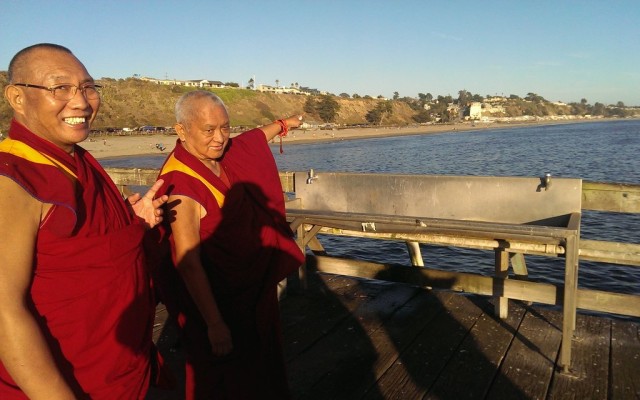
Rinpoche pointing out to Dagri Rinpoche where Lama Yeshe lived. Rinpoche’s house is “by chance” only a few miles away. “It wasn’t planned, it just happened like that!” Aptos, California, September 28, 2013. Photo by Ven. Roger Kunsang.
Lama Zopa Rinpoche has been in the United States for the last three weeks, staying at Kachoe Dechen Ling, his home in Aptos on California’s central coast. On September 28, Lama Zopa Rinpoche and Dagri Rinpoche, who was in California offering teachings at Land of Medicine Buddha, went out on a local pier to bless all the sentient beings in the ocean.
While in California, Lama Zopa Rinpoche regularly goes to the ocean with specially made Namgyälma mantra boards that are lowered into the water to bless all the beings. You can read more about the Namgyälma mantra and blessing the animals in the ocean on Mandala.
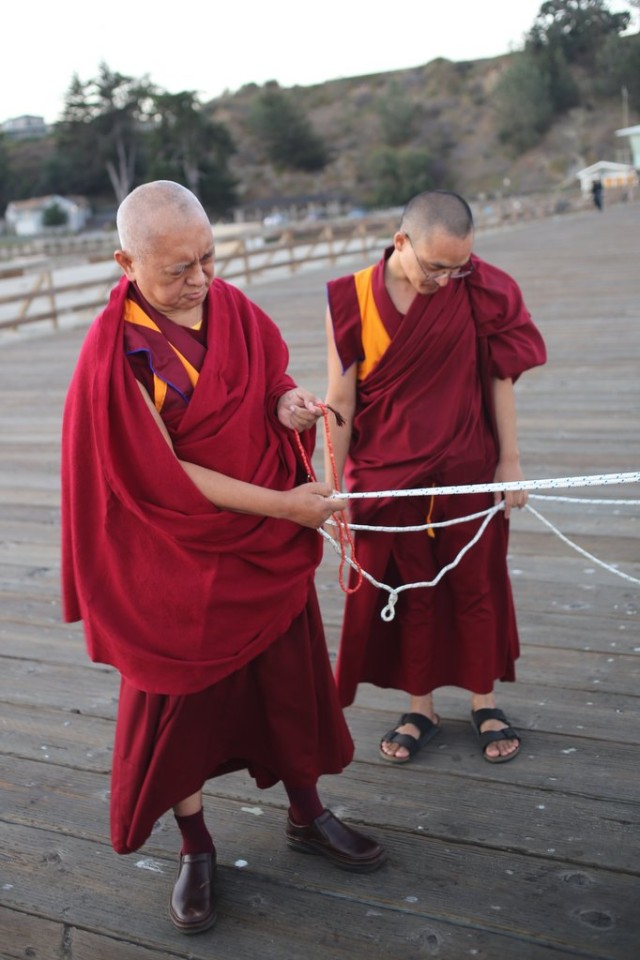
Lama Zopa Rinpoche holding ropes attached to mantra boards blessing beings in the ocean, Aptos, California, September 14, 2013. Photo by Ven. Thubten Kunsang.
If you like what you read on Mandala, consider becoming a Friend of FPMT, which supports our work.
- Tagged: animals, lama zopa rinpoche, mandala, namgyalma mantra
- 0

New prayer wheels from Nepal installed at the Garden of Enlightenment, Chenrezig Institute, Queensland, Australia, 2013. Photo by Ray Furminger.
From Garrey Foulkes
At the Garden of Enlightenment, a project of Chenrezig Institute in Queensland, all of the spaces for prayer wheels along the front wall of the main shrine building are now taken. The main building of the stupa garden serves as the base for eight great stupas, the largest of which is 10 meters (33 feet) tall. The shrine and stupas are surrounded by ornamental gardens. The prayer wheels along the front wall are colored wheels and were made at the Chenrezig art studio. They are very difficult to construct and expensive to produce. So on a recent trip to Kopan Monastery in Nepal, we looked at copper and brass wheels and decided to use the Nepali wheels for the remaining walls. They are far more practical, will last longer and, because of their slightly smaller size, we can fit many more prayer wheels along the walls. We received the first shipment of ten in April and already six have been sponsored.
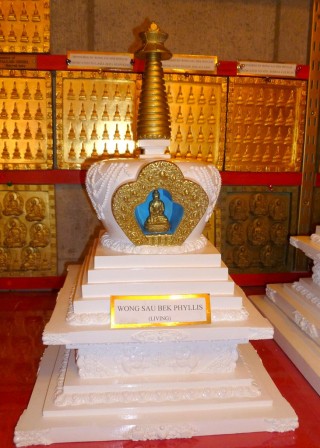
Stupa and wall of tsa-tsa tiles in shrine at Garden of Enlightenment, Queensland. Photo by Ray Furminger.
One very positive thing that has happened over the past three or four years is we are getting regular visits from schools to Chenrezig Institute and the Garden of Enlightenment. Often the students are coming from Christian colleges, when they are doing assignments on different religions. When they visit the gardens, we usually split into a few groups and senior students talk them through the project and encourage general questions. The result always seems to be positive as most of the questions are well thought through, often brilliant and sometimes hilarious.
We continue to offer half of the money donated for tsa-tsa tiles on the internal walls of the shrine building to the Maitreya Project. Small memorial stupas are also located inside the building as well as being placed throughout the gardens.
Mandala brings you news and updates from over 160 FPMT centers, projects and services around the globe. If you have a story to share, please let us know.
30
Geshe Lobsang Sherab Passes Away
Geshe Lobsang Sherab was born in 1965 to a local family in Manang, a mountainous area in Nepal near Annapurna. He went to Kopan Monastery in Kathmandu in 1974 and was ordained there. Geshe Sherab studied at Sera Monastic University in South India, where he completed his Geshe degree. He was a resident geshe at Kopan Monastery and was one of the main philosophy teachers there. Geshe Sherab also served FPMT as a resident geshe at Losang Dragpa Centre in Malaysia and Shakyamuni Center in Taiwan.
Geshe-la died suddenly on the afternoon of Wednesday, September 25 at Kopan. After his death, prayers and pujas were done by groups of monks day and night until the cremation. Lama Chöpa was performed and the eight auspicious prayers were recited in the evenings by the whole monastic community. The tantric monks performed Yamantaka sadhana and self-initiation. The Khachoe Ghakyil (Kopan) nuns performed Vajrayogini self-initiation.
The cremation took place on Friday, September 27, following the advice of Lama Zopa Rinpoche and Khen Rinpoche Geshe Chonyi, the current abbot of Kopan. During the cremation, Yamantaka sadhana and fire puja were performed. All the senior monks and nuns as well as a great number of laypeople attended the cremation.
Mandala will print a complete obituary for Geshe Lobsang Sherab in the January-March 2014 issue.
- Tagged: geshe lobsang sherab, kopan monastery, mandala
- 0
25
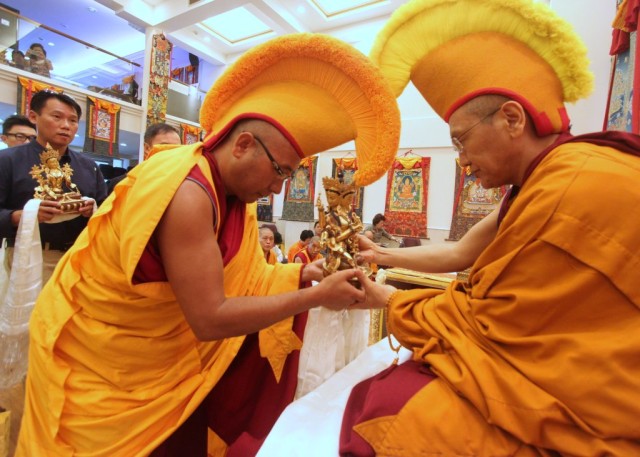
Khen Rinpoche Geshe Chonyi receiving offering from Geshe Sherab at long life puja, Amitabha Buddhist Centre, Singapore, July 2013. All photos by Tan Seow Kheng; courtesy of ABC.
By Ven. Tenzin Tsultrim
In July 2013, Khen Rinpoche Geshe Chonyi accepted his first long life puja in the presence of some 200 students and well-wishers at Amitabha Buddhist Centre (ABC) in Singapore. Khen Rinpoche, who is ABC’s resident teacher as well as the abbot of Kopan Monastery and Nunnery, said he enjoyed receiving the puja, which was organized to celebrate his 51st birthday.
For 10 years, Khen Rinpoche joked, he was used to being the one making the offerings during the long life ceremonies for Lama Zopa Rinpoche and Khensur Rinpoche Lama Lhundrup. This time, the ritual master was Geshe Thubten Sherab, who had accepted the invitation to travel from Kopan Monastery for the occasion. The puja itself was led by the chanting master of Kopan Monastery, Geshe Lobsang Sherab. The resident teachers and directors of the three FPMT centers in Malaysia also made a special trip to Singapore to be part of the celebration.
Khen Rinpoche spoke before the puja on how to make the practice meaningful:
We all know what Lama Zopa Rinpoche has mentioned before about the long life puja. Mainly when we offer long life puja to the gurus, we have a Dharma connection with them. From your heart, when you make strong requests for the gurus to live long, that helps the guru to live long. The whole point why you are requesting is because you see some benefit for the guru to live long. If you can see from your heart why the guru needs to live long, then make single-pointed request to the gurus. When you request the guru to live long, at the same time you yourself have long life. That is the benefit. Both of you [guru and disciple] get the benefit.
When you do the long life puja, it is mainly the practice of Guru Puja. Remember to visualize or think that your own guru is in front of you. It doesn’t have to be me. Those who have a close Dharma connection with your own gurus, you can visualize them. Then you make these extensive offerings to the guru from your heart, and make strong requests for the guru to live long.
Make sure, as you are doing the Guru Puja, to make it meaningful for yourself. When you do it well, that means you are closer to the gurus. That means you are closer to enlightenment, closer to the Buddha, closer to the Dharma, closer to the Sangha. Make sure you do that. I think it is extremely important.
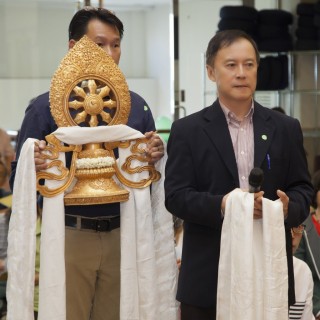
ABC vice-president Fred Cheong and director Tan Hup Cheng presenting Dharma wheel, Singapore, July 2013
Among the procession of offerings presented to Khen Rinpoche was an impressively large Dharma wheel, a gift from the center and the second batch of Basic Program students whom Khen Rinpoche has taught for the past two years. Representing the center and the students, ABC’s director Tan Hup Cheng and vice-president Fred Cheong presented the gigantic wheel to Khen Rinpoche together with a strong request that he would continue to teach at ABC for a very long time.
Besides the Basic Program, Khen Rinpoche teaches a weekly lam-rim class that is translated for Chinese speakers, and a monthly “Dharma for Seniors” class. Khen Rinpoche has also formed a bond with some of the youngest members of ABC, including ten-year-old Melody Wee, who offered a song. Her mature and captivating rendition of “If We Hold on Together” held all the grown-ups in misty-eyed rapture.
At the end of the puja, Khen Rinpoche offered an insight into his life and why he has continued to stay as ABC’s resident teacher:
I was born in 1962. I spent 12 years with my family. After that I spent six years in Kopan Monastery, then I spent another 18 to 19 years in South India, then I spent 14 years in Singapore.
When I look back at myself, how I became a monk is because I met Lama Yeshe, the first time when I was aged 12, in 1974. Lama Yeshe came all the way to my hometown and I met him there. Because of that I was able to become a monk, to be ordained. After I became ordained I spent six years at Kopan. I was able to stay as a monk because of the late ex-abbot Lama Lhundrup. When I was 15 to 17 years old, my mind was always wandering. It was not an easy time, under different conditions. Because of his advice, I was able to remain as a monk at that time. After that I moved to South India. I had all this education [at Sera Je Monastery]. All this depended one hundred per cent on my teacher [Khensur Rinpoche Lobsang Tsering, ex-abbot of Sera Je Monastery]. Because of his kindness, I was able to complete my studies at the level of geshe. After that, I came to Singapore.
Being able to live here for 14 years is all from depending on Lama Zopa Rinpoche’s advice. I mentioned before, when I came for the first time to Singapore, I thought I would stay just one year. I told my friends, everybody, I would try for one year. After one year I will be back, I said! Somehow I have stayed until now, because of Rinpoche’s advice.
Why I have stayed here so long is because of the members and students of Amitabha Buddhist Centre, because they all have some interest to learn Buddhadharma. That is the main thing that has made me stay here, so far, because I see that people have interest, put in effort. Some of them really, for 14 years they are here with me, without missing class, twice a week. When I see their lives, how busy they are. They have to work from morning to night. Also, they have families, have to go out with the family, need time for the family, but still they put in so much effort and come to class. So really, that really makes me stay in Singapore, here, to teach. That is the main reason. How long I stay here all depends on that. Entirely depends on that.
In keeping with the occasion of celebrating Khen Rinpoche’s birthday, there was a festive mood to the puja. And true to Singapore’s culture, the celebration was made complete with hearty eating, a Thai-style lunch buffet treat for everyone from ABC’s Executive Committee, who requested Khen Rinpoche to accept the long life puja and who also organized it.
Mandala brings you news of Lama Zopa Rinpoche and of activities, teachings and events from over 160 FPMT centers, projects and services around the globe. If you have news you would like to share, please let us know.
It’s a big week for Wisdom Publications, a leading publisher of Buddhist books and an affiliate of FPMT. The Somerville, Massachusetts-based publisher announced a new website with a new blog as well as a new distribution arrangement with the international publisher Simon and Schuster.
“We look forward to working with Simon and Schuster to better fulfill our mission of nurturing communities of readers and authors by being a source of high quality, polished and carefully chosen works,” said Tim McNeill, Wisdom Publications CEO.
While Wisdom publishes books from all major Buddhist traditions, the publisher’s catalog of Tibetan Buddhist titles is unparalleled and includes the exceptional Library of Tibetan Classics series as well as titles by many 20th-century Tibetan Buddhist masters.
Wisdom origins stretch back to Lama Yeshe and Lama Zopa Rinpoche’s early days of teaching Dharma to Westerns at Kopan Monastery in Nepal. Ven. Robina Courtina and Lama Yeshe Wisdom Archive director Nick Ribush were involved in the early development of Wisdom Publications. Tim McNeill, a long-time FPMT student and current member of the FPMT Inc. Board of Directors, has led Wisdom and its impressive staff for the past 25 years.
If you like what you read on Mandala, consider becoming a Friend of FPMT, which supports our work.
- Tagged: tim mcneill, wisdom publications
- 0
19
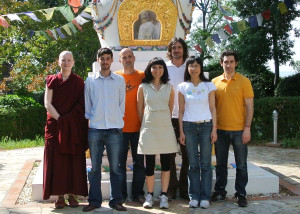
Masters Program students (left to right): Ven. Tiziana Losa, Jacob Fisher, Yaniv Sagi, Marina Brucet, Hans Burghardt, Yumi Terada and Joan Dombón, Istituto Lama Tzong Khapa, Pomaia, Italy, July 2013. Photo courtesy of ILTK.
The second cycle of the FPMT Masters Program at Istituto Lama Tzong Khapa (ILTK), Pomaia, Italy, is coming to a close. Students of the Masters Program class of 2008-2013 at ILTK are currently preparing for their final exams. Marina Brucet (Spain), Yumi Terada (Japan), Ven. Tiziana Losa (Italy), Hans Burghardt (Spain) and Jacob Fisher (England) have all participated in this Masters Program from the very beginning. They were interviewed for the October-December 2013 issue of Mandala about their backgrounds, their studies up to now and their upcoming retreats.
What was the best part of the Masters Program for you?
Marina: [The best has been] all I’ve learned about Buddhist philosophy, especially on emptiness and on the view of the Buddhist path. Parallel to that, the program gives you the conditions to practice Dharma and to work a lot on transforming your mind as you face all the different phases you go through when engaging in such deep studies. It also gave me the opportunity to start teaching introduction to meditation, which I appreciate very, very much.
Yumi: For me, it was Guhyasamaja Tantra because it was the culmination of all the presentations that we had studied before this text.
Ven. Tiziana: It is difficult to say, because all the texts have their own particular purpose, and they are all necessary to give an overview on the entire path.
Jacob: For me, it was studying the tantra modules with Geshe Gelek, as I found this part of the studies much easier to relate to. The transmission of the knowledge from the various realized lineage masters seemed so much closer and more direct. It also showed me in a much more precise way how an unenlightened mind can become free and transformed into that of a buddha. Geshe-la has a very profound knowledge of this area. I found his teachings very lucid and they helped me understand the great depth and intensiveness of the various teachings of tantra in this lineage.
Hans: Aside from the amazing teachings from Khensur Rinpoche Jampa Tegchok on the Madhyamakavatara and many other things, the best was the possibility to start teaching introductory courses. I’ve learned a lot from those whom we usually label as “beginners.” They’ve also given me a boost of motivation to further deepen my practical knowledge and to develop and strengthen the wish to go on one retreat after another for as long as possible, before I start teaching, to be able to give them as much as possible.
From Mandala October-December 2013
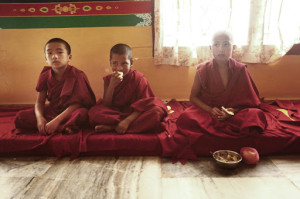
Young monks from Sera Je benefit from the meal provided by the Sera Je Food Fund. Photo courtesy https://photos.app.goo.gl/C4MnbETKrdyayPtU6
In Mandala October-December 2013, Geshe Thubten Jinpa writes about the benefits of the Sera Je Food Fund, an FPMT Charitable Project dedicated to offering three meals a day to the 2,500 monks of Sera Je Monastery.
A 78-year-old monk walks back and forth two times every day for the meal being served in the main prayer hall of Sera Je Monastic University, situated in South India. After each meal, he comes back with a half-loaf of bread that he did not finish. I thought the leftover bread would go in the garbage bin, but I was wrong. He puts the bread in the sun and lets it dry. Later in the day when his young disciples come back hungry from class, he offers the dry piece of bread as a snack with a cup of black tea.
This old monk has been doing this for decades. Now it is just a habit, but 30 years ago he started this ritual out of helplessness and responsibility. In those days, senior monks who had young disciples had to save half of their food so that their young pupils could eat and be able to continue their studies in the evening without an empty stomach.
… Today, the Sera Je Food Fund provides highly nutritious meals, hygienically prepared for thousands of monks every day. Since the food fund started in 1991, the health of all the monks improved dramatically. They are now able to devote their full time to their Dharma studies without worrying about their meals or if they will have enough food. The most significant impact of the Sera Je Food Fund can be seen by the increase of numbers of the monks, and that senior monks like Geshe Wangchen are now able to accept as many new students as they can without worry.
From Mandala October-December 2013
Currently, the Sera Je Food Fund offers over 3 million meals annually. You can learn more about the fund and make a contribution to the project online.
13
Land of Joy: An Interview with Andy Wistreich
Thomas: What elements will be incorporated into the retreat community?
Andy: The core elements of Land of Joy will be the group retreat and conference facilities, the solitary retreat huts, the contemplative community, the Tara Hospice Care service and a monastic community. There will be an organic market garden and orchard providing as much as possible of the food consumed at Land of Joy, sustainable energy generating plant and a library. Group retreats, conferences and courses will be provided by both the center and by partner organizations on a hire-out basis. The contemplative community will be for adults of all ages who wish to lead a semi-retreat lifestyle based on Buddhist refuge. Members of this community will link up with other community members living nearby the center for a range of Dharma activities such as meditations, discussion groups and pujas. It is anticipated that they will also help to provide a program of Buddhist and related courses, groups and activities for people living in the area. The Tara Hospice Care service will start out by training volunteers to give non-medical end-of-life support in the local community. In due course, it is hoped to develop a small hospice at Land of Joy providing for one or two resident patients. The monastic community will begin with either a monastery or nunnery for a small number of ordained Sangha residents. In due course we hope to establish both at Land of Joy.
Thomas: Will Land of Joy only be for Buddhists?
Andy: Land of Joy will welcome people of all faiths and none, who are interested in the benefits of retreat. The program of retreats offered by Land of Joy will reflect a very diverse range of needs and preferences. There is no reason why retreats led by members of non-Buddhist faiths may not take place there as partner programs. It is intended to offer a range of Universal Education activities and retreats for various groups. There will be activities for youth, families and other special interest groups. There will be programs of secular retreats on either mindfulness or compassion training. At the heart of the program will be traditional Buddhist retreats in the FPMT tradition, covering a diverse range of Sutrayana and Vajrayana practices, and including regular visits by high lamas giving Vajrayana empowerments and teachings. Land of Joy will be a place of learning and contemplation for everyone. …
From Mandala October-December 2013
If you like what you read on Mandala, consider becoming a Friend of FPMT, which supports our work.
9
Achieving Realizations of the Path
Lama Zopa Rinpoche has recently been commenting on the need for FPMT students to actualize the lam-rim teachings and achieve realizations. You can read Rinpoche’s recent advice in the just-published Mandala October-December 2013:
Special group of retreatants
First of all, I want to say that the FPMT has been developing now for many years and over that time people have been studying and practicing the Dharma according to their ability. Generally, when I look at the FPMT organization, what I see is that the students have developed more compassion and good-heartedness. This is extremely worthwhile because compassion for all sentient beings is the very heart of Buddhism; it is the most important Dharma practice for the happiness of the individual students, for their families, for society, for the country, for the world and for the six realms’ sentient beings.
There has been a lot of study and the study is going well; there is Discovering Buddhism, the Basic Program and the Masters Program. Particularly in the Gelugpa tradition there is a lot of teaching and learning philosophy, and in the FPMT organization we have been doing that. Buddhist philosophy is now being studied in almost every center, especially where there is a resident geshe. We even have Western students who have completed the Masters Program and can teach philosophy where there is no geshe, or even where there is a geshe. There are more centers teaching the Masters Program and some centers have already taught the Basic Program several times. People have been learning about Buddhism, and especially the lam-rim, for quite some time now in the FPMT and there are some who are also trying to meditate and practice the lam-rim.
Now what is needed are people who will sacrifice their lives, as they did in India, Tibet and Nepal, not just to study the Dharma like at a college or university, but to actualize the teachings in a monastery or isolated place. In Tibet, the mountains were full of caves like ants’ nests, where people would go to practice without distraction. When I came from Solu Khumbu [in Nepal] to Tashi Lhunpo Monastery in Tsang [Tibet] and then on to Pagri [in Tibet] there were many caves along the road where meditators would practice with hardship and the realizations of guru devotion, renunciation, bodhichitta, right view and the two stages of tantra would all come. Wow, wow, wow. It’s unbelievable! That’s why the country of Tibet is so blessed and so precious because there are many, many caves where meditators, like Milarepa, for example, achieved different realizations, such as the rainbow body.
This is how Buddhism really comes alive – when it is not just words, not just scholars, but really living Buddhism. When study and realization come together, Buddhism will really last. Wow, then like an ocean in the heart and the mind, it will spread and be preserved. …
From Mandala October-December 2013
If you like what you read on Mandala, consider becoming a Friend of FPMT, which supports our work.
- Tagged: mandala, teachings and advice
- 0
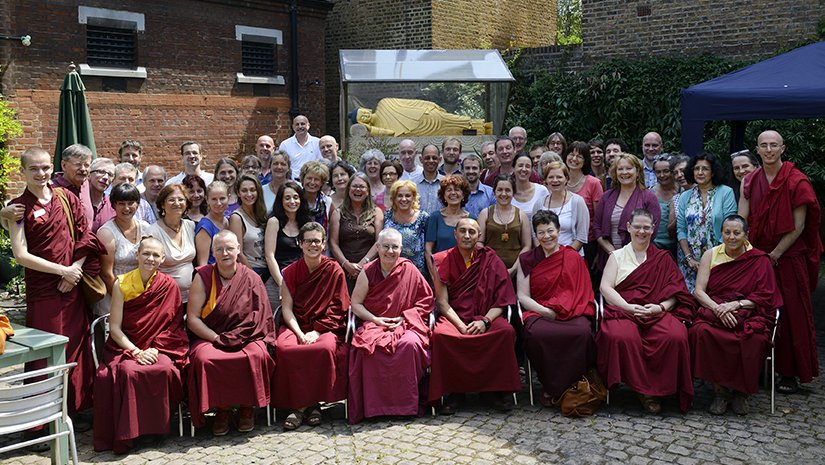
Participants in European Regional Meeting, Jamyang Buddhist Centre, July 2013. Photo by Natascha Sturny.
Jamyang Buddhist Centre London “hosted a successful and very happy Europe Region Annual meeting in July,” wrote Jamyang’s Adnan Hadzi.
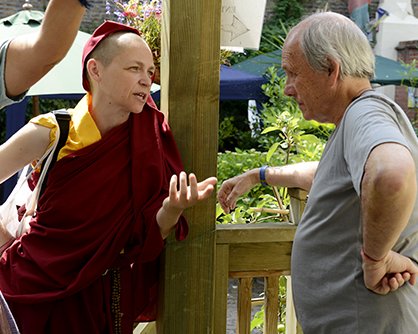
Meeting delegates enjoy the sun and a chance to talk, Jamyang Buddhist Centre, July 2013. Photo by Natascha Sturny.
“Sixty delegates from 15 countries in Europe met to discuss the benefits of five-year rolling plans, how they could improve their governance and improve the range of courses they offer, and to formulate plans for their groups for next year. It was very inspiring meeting our FPMT family members from all over Europe,” Adnan wrote.
Jamyang also shared some great photos from the event with Mandala.
Mandala brings you news of Lama Zopa Rinpoche and FPMT activities, teachers and events from over 160 FPMT centers, projects and services around the globe. If you have news you would like to share, please let us know.
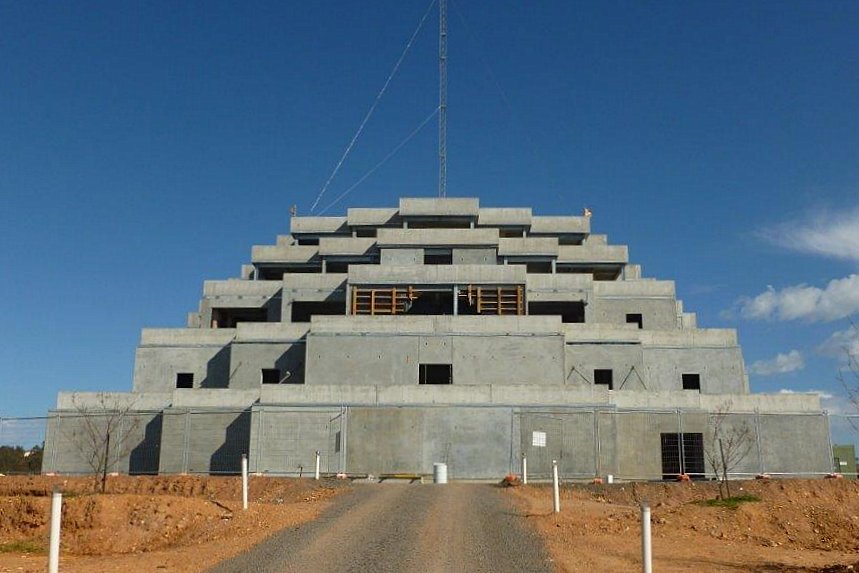
Great Stupa of Universal Compassion, Victoria, Australia, August 2013. Photo courtesy of Ian Green via Twitter.
The Great Stupa of Universal Compassion continues to rise from the bush of Victoria, Australia. The massive project has been captured in an impressive new video that shows the current development of the 50-meter [164-foot] stupa in Maiden Gully, near Bendigo.
Video: Great Stupa of Universal Compassion
The video was shot by a camera attached to a “mini-drone,” providing amazing aerial views of the grounds and stupa, which when completed will be the same size and design as the Great Stupa of Gyantse in Tibet and will house a gompa, many large holy statues as well as sacred relics. In addition to construction on the stupa, workers are busy with planting and landscaping the grounds. Rosemary and lavender are currently being planted.
The development of the Great Stupa began in the mid-1990s. Ian Green, a long-time student of Lama Yeshe and Lama Zopa Rinpoche, directs the $20-million project. In a 2011 interview with Mandala, he talked about the history of the site, its progress and his involvement with FPMT.
Reflecting on the project’s pace of development, Ian said, “Rinpoche has commented that the way the Great Stupa has been built is a good example for other major projects to follow. He described our careful, steady progress as being like an aircraft on a runway which takes quite a while to get to maximum speed before taking off and soaring to great heights. He said, and I agree totally with him, that the biggest danger is to leap into things before you are prepared. These leaps can lead to crashes which can set major projects back for a very long time. Unfortunately, first impressions really do last a very long time.”
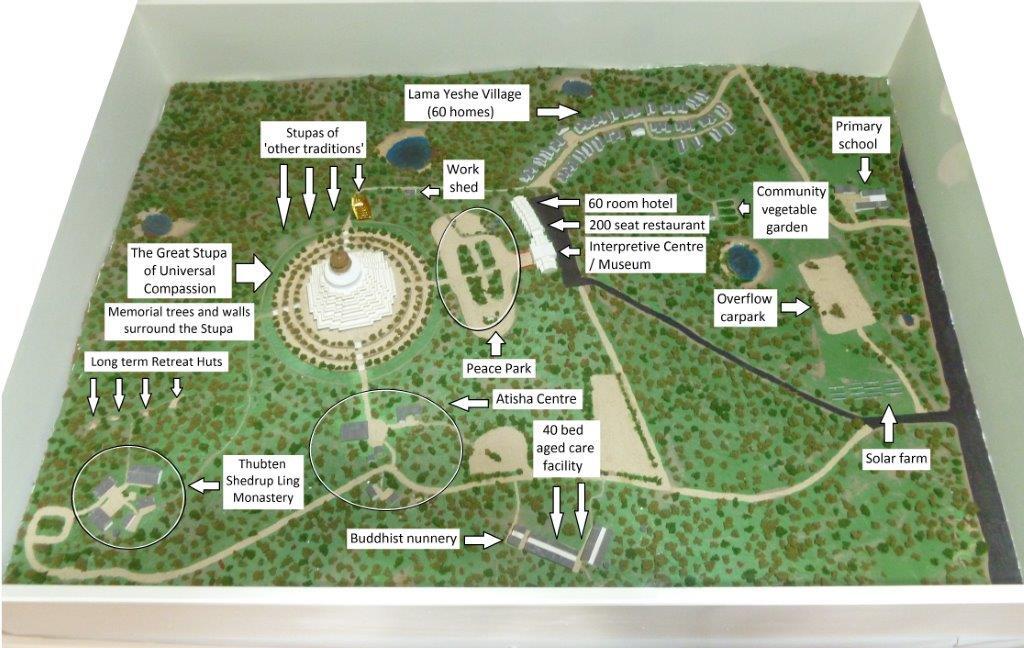
Three-dimensional model of master plan for development at Great Stupa. Image courtesy of Ian Green via Twitter.
Atisha Centre and Thubten Shedrup Ling share the large grounds with the stupa and are integral to the flowering of the vast long-range vision of a Buddhist community, which Ian describes in the interview and can be seen in a three-dimensional model of the master plan for the site, currently with the local Bendigo Council.
You can find more photos and news from the Great Stupa on Twitter and Facebook. For more information on the project, visit the Great Stupa’s website.
Mandala brings you news of Lama Zopa Rinpoche and FPMT activities, teachers and events from over 160 FPMT centers, projects and services around the globe. If you have news you would like to share, please let us know.
- Tagged: great stupa of universal compassion, ian green, mandala
- 0
- Home
- News/Media
- Study & Practice
- About FPMT Education Services
- Latest News
- Programs
- New to Buddhism?
- Buddhist Mind Science: Activating Your Potential
- Heart Advice for Death and Dying
- Discovering Buddhism
- Living in the Path
- Exploring Buddhism
- FPMT Basic Program
- FPMT Masters Program
- FPMT In-Depth Meditation Training
- Maitripa College
- Lotsawa Rinchen Zangpo Translator Program
- Universal Education for Compassion & Wisdom
- Online Learning Center
- Prayers & Practice Materials
- Overview of Prayers & Practices
- Full Catalogue of Prayers & Practice Materials
- Explore Popular Topics
- Benefiting Animals
- Chenrezig Resources
- Death & Dying Resources
- Lama Chopa (Guru Puja)
- Lama Zopa Rinpoche: Compendium of Precious Instructions
- Lama Zopa Rinpoche: Life Practice Advice
- Lama Zopa Rinpoche Practice Series
- Lamrim Resources
- Mantras
- Prayer Book Updates
- Purification Practices
- Sutras
- Thought Transformation (Lojong)
- Audio Materials
- Dharma Dates – Tibetan Calendar
- Translation Services
- Publishing Services
- Teachings and Advice
- Find Teachings and Advice
- Lama Zopa Rinpoche Advice Page
- Lama Zopa Rinpoche: Compendium of Precious Instructions
- Lama Zopa Rinpoche Video Teachings
- ༧སྐྱབས་རྗེ་བཟོད་པ་རིན་པོ་ཆེ་མཆོག་ནས་སྩལ་བའི་བཀའ་སློབ་བརྙན་འཕྲིན།
- Podcasts
- Lama Yeshe Wisdom Archive
- Buddhism FAQ
- Dharma for Young People
- Resources on Holy Objects
- Ways to Offer Support
- Centers
- Affiliates Area
- Teachers
- Projects
- Charitable Projects
- Make a Donation
- Applying for Grants
- News about Projects
- Other Projects within FPMT
- Support International Office
- Projects Photo Galleries
- Give Where Most Needed
- FPMT
- Shop
Subscribe to FPMT News
Translate*
*powered by Google TranslateTranslation of pages on fpmt.org is performed by Google Translate, a third party service which FPMT has no control over. The service provides automated computer translations that are only an approximation of the websites' original content. The translations should not be considered exact and only used as a rough guide.FPMT is unbelievably fortunate that we have many qualified teachers who are not only scholars but are living in practice. If you look, then you can understand how fortunate we are having the opportunity to study. With our Dharma knowledge and practice we can give the light of Dharma to others, in their heart. I think that’s the best service to sentient beings, the best service to the world.







